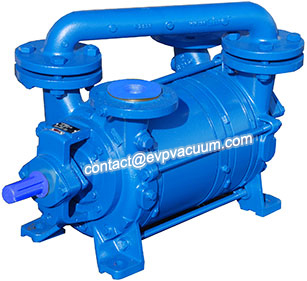Vacuum pump pumping test
Any vacuum pump to be repaired, repaired vacuum pump or a new vacuum pump shall be tested to check whether there is any fault, the form and position of the fault, the limit vacuum degree that can be reached and the time that it has experienced. If there is any condition, it is necessary to identify the pumping rate.
The specific methods and steps of test sampling are as follows:
1. Clean all parts of the vacuum pump to remove oil and dirt. Remove the belt, and use the reverse switch to test the positive and negative rotation of the motor, so that its rotation direction is consistent with the arrow direction marked by the pump wheel. If there is no mark on the pump wheel, press the air inlet of the pump with your palm, and turn the pulley with the other hand. When you feel that there is suction inward, the rotation direction of the pulley is the correct direction, and make a mark. Then install the belt. Connect the test device at the air inlet of the pump before starting the pump. Usually, one end of the vacuum rubber tube is inserted into a thermocouple gauge tube, and the other end is inserted into the air inlet of the vacuum pump to be tested. Before this, a little castor oil should be applied on the rubber pipe mouth to make it lubricated and easy to plug. The rubber pipe is clamped with an iron clip (if it is connected with a metal pipe, it is connected with a flange at the pump port, and the other end is sealed with a metal glass to connect with a gauge pipe or with a gauge pipe joint, and there is a vent valve in the middle of the pipe). First, turn the pulley by hand for several turns. If there is no big obstacle, the motor can be started intermittently. Run the pump properly.
2. Check the operation of the vacuum pump: listen to the pump sound for noise and abnormal sound; see how the valve plate of the air port is beating; check whether the oil reaches the oil standard center, and whether there is oil leakage, air leakage and water leakage; check whether the surface of the pump cavity is deformed, etc. make records one by one
3. Check the change of vacuum degree with high frequency spark leak detector and thermocouple vacuum gauge. The spark is hit on the neck of the gauge tube (not on the gauge tube), and the vacuum degree can be judged by the glow color; normally, the glow color will gradually change from dark purple and rose red to light blue after the pump is turned on, until the glow is very tiny, only the fluorescence of the glass is seen, at this time, the vacuum degree has been higher. After the glow changes to light blue, the thermocouple vacuum gauge can be used to monitor the vacuum degree. At the beginning, it can also be measured by thermocouple vacuum gauge alone. However, the two should not be carried out at the same time to avoid damage to the thermocouple gauge. If the spark detector is used to move back and forth on the glass tube during the inspection, and the glow cannot be produced, and the spark can drill into the glass tube to form a linear shape, it indicates that the vacuum degree is very low (close to atmospheric pressure). If it is always purple, and the vacuum degree of the pump is not high, check all parts of the pump carefully to see if there is air leakage at the rubber pipe joint, etc. If the thermocouple gauge has certain indication when measuring the vacuum degree, it can clamp the iron clamp or stop the pump suddenly for a short time to record the pressure change curve with time, and judge whether the pump is bad or caused by air leakage. It is necessary to carefully distinguish the different conditions of three curves of air leakage, air release and pump damage, and make careful judgment.
When using thermocouple vacuum timing, pay attention to its test characteristics. The vacuum degree it measures is the total pressure of gas including water and oil vapor. The reading is related to the type of gas. In the vacuum pump identification, it is required to measure the partial pressure of the permanent gas with the compressed vacuum gauge, which is independent of the type of gas. Therefore, in the test pumping, it should be compared with the original data to judge whether the vacuum degree of the pump is “low”. Before the pump is connected to the vacuum system for use, the ultimate vacuum degree it can reach shall also be measured during the test pumping. For example, it is 2 × 10-2 Torr ((65 grid) (1 Torr = 133pa) measured by thermocouple vacuum gauge, and 5 × 10-4 Torr may be measured by compression vacuum gauge, just in accordance with the index on the pump label. When repairing the pump, if the vacuum degree is less than 2 × 10-2 Torr, for example, only less than 40 grid ((4 × 10-2 Torr), it can be considered that the vacuum degree of the pump is low, and it should be repaired and adjusted properly. If the pump does not record the original data, it can be generally considered that it should be repaired if it is less than 50 grids. Naturally, whether the vacuum pump needs to be repaired mainly depends on the actual production needs and possible conditions.
(The article comes from the Internet. If reprinting is not allowed, please contact our company to delete it.)

